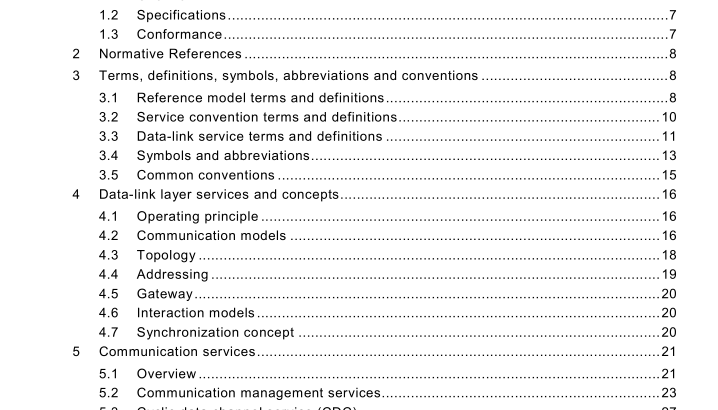IEC 61158-3-22:2010 pdf download – Industrial communication networks – Fieldbus specifications – Part 3-22: Data-link layer service definition – Type 22 elements
1scope1.1overview
This part of IEC 61158 provides common elements for basic time-critical messagingcommunications between devices in an automation environment. The term “time-critical isused to represent the presence of a time-window, within which one or more specified actionsare required to be completed with some defined level of certainty. Failure to completespecified actions within the time window risks failure of the applications requesting theactions, with attendant risk to equipment,plant and possibly human life.
This standard defines in an abstract way the externally visible service provided by the Type22 fieldbus data-link layer in terms of:
a) the primitive actions and events of the service;
b) the parameters associated with each primitive action and event,and the form which theytake; and
c) the interrelationship between these actions and events,and their valid sequences.The purpose of this standard is to define the services provided to:
.the Type 22 fieldbus application layer at the boundary between the application and data-link layers of the fieldbus reference model; and
.systems management at the boundary between the data-link layer and systems
management of the fieldbus reference model.
1.2Specifications
The principal objective of this standard is to specify the characteristics of conceptual data-linklayer services suitable for time-critical communications,and thus supplement the OSl BasicReference Model in guiding the development of data-link protocols for time-criticalcommunications.A secondary objective is to provide migration paths from previously-existingindustrial communications protocols.
This specification may be used as the basis for formal DL-Programming-Interfaces.Nevertheless, it is not a formal programming interface, and any such interface will need toaddress implementation issues not covered by this specification, including:
a) the sizes and octet ordering of various multi-octet service parameters; and
b) the correlation of paired request and confirm, or indication and response,primitives.1.3Conformance
This standard does not specify individual implementations or products,nor do they constrainthe implementations of data-link entities within industrial automation systems.
There is no conformance of equipment to this data-link layer service definition standard.lnstead,conformance is achieved through implementation of the corresponding data-linkprotocol that fulfils the Type 22 data-link layer services defined in this standard.
2Normative References
The following referenced documents are indispensable for the application of this document.For dated references, only the edition cited applies.For undated references, the latest editionof the referenced document (including any amendments) applies.
ISO/IEC 7498-1,Information technology – Open Systems Interconnection – Basic ReferenceModel: The Basic Model
ISO/IEC 7498-3,Information technology – Open Systems Interconnection – Basic ReferenceModel: Naming and addressing
ISO/IEC 10731,Information technology – Open Systems Interconnection – Basic ReferenceModel – Conventions for the definition of osi services
ISO/IEC 8802-3:2000,Information Technology – Telecommunications and informationexchange between systems -Local and metropolitan area networks – Specific requirements -Part 3: Carrier sense multiple access with collision detection (CSMA/CD) access ‘method andphysical layer specifications.
3 Terms, definitions, symbols, abbreviations and conventions
For the purposes of this document,the following terms,definitions,symbols,abbreviationsand conventions apply.
3.1Reference model terms and definitions
This standard is based in part on the concepts developed in ISOIEC7498-1 andISO/IEC 7498-3, and makes use of the following terms defined therein:
DL-address [ISO/IEC 7498-3]
called-DL-address [ISO/IEC 7498-3]
calling-DL-address [ISO/IEC 7498-3]
DL-connection [ISO/IEC 7498-1 ]
DL-connection-end-point [ISO/IEC 7498-1 ]
DL-connection-end-point-identifier [ISO/IEC 7498-1 ]
DL-connection-mode transmission [ISO/IEC 7498-1 ]
DL-connectionless-mode transmission [ISO/IEC 7498-1 ]
3.3 Data-link service terms and definitions
3.3.1
acyclic data
data which is transferred from time to time for dedicated purposes
3.3.2
cell
synonym for a single DL-segment which uses RTFL communication model
3.3.3
communication cycle
fixed time period between which the root device issues empty frames for cyclic communication initiation in which data is transmitted utilizing CDC and MSC
3.3.4
cycle time
duration of a communication cycle
3.3.5
cyclic
events which repeat in a regular and repetitive manner
3.3.6
cyclic communication
periodic exchange of frames
3.3.7
cyclic data
data which is transferred in a regular and repetitive manner for dedicated purposes
3.3.8
cyclic data channel (CDC)
one or more frames, which are reserved for cyclic data
3.3.9
data
generic term used to refer to any information carried over a fieldbus
3.3.1 0
device
physical entity connected to the fieldbus
